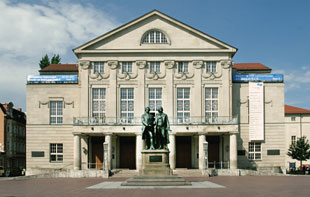The acquisition of a Studer Vista 8 mixing console and TiMax2 SoundHub-R32 system matrix and playback server places the Deutsches NationalTeater in Weimar on the cutting edge of digital theatre sound systems.
 TiMax SoundHub was chosen by the theatre’s sound crew (Tonmeister Moritz Kobel, Tonmeisterin Sarah Hölscher and Tontechniker Uwe Kohlhaas) for its dynamic delay-matrix SOR localisation capabilities combined with comprehensive general housekeeping functions of linkable eight-band parametric system EQ, routing and multi-zone level grouping.
TiMax SoundHub was chosen by the theatre’s sound crew (Tonmeister Moritz Kobel, Tonmeisterin Sarah Hölscher and Tontechniker Uwe Kohlhaas) for its dynamic delay-matrix SOR localisation capabilities combined with comprehensive general housekeeping functions of linkable eight-band parametric system EQ, routing and multi-zone level grouping.
Audio is transported between TiMax and the console using a combination of Madi and analogue I/O, while a patchbay allows other sources to access the TiMax directly. The TiMax SoundHub analogue outputs feed Crown Macrotech MA600 amplifiers,via a splitter to allow TiMax to also deliver occasional feeds to additional mobile active speakers.
Replacing an old analogue Studer and legacy TiMax Classic matrix – which had been in daily use for the past ten years – the new TiMax SoundHub system was purchased from distributor Pro Audio Technik following on-site demos by the company’s TiMax technical sales specialist, Matthias Ziegenberger.
The theatre’s loudspeaker system consists of 12 Meyer Sound UPA theatre cabinets and 20 compact Meyer Sound UPM boxes. The main PA is an LCR system comprising 12 UPAs above the stage, with another eight as delays and fills. The UPMs are mounted around the audience as delay fills and for surround sound effects. The TiMax SoundHub handles system management, eqalisation, zone control, and delay-matrixing of the entire distributed speaker system. Additionally, multiple sets of Image Definition delay-matrix presets provide a library of on-stage vocal localisation and surround sound effects pan points for the varied show configurations which the theatre has to accommodate.
‘With the TiMax SoundHub we can manage even complex speaker set-ups very easy,’ says Head of Sound, Moritz Kobel. ‘That’s especially useful in the Weimar theatre, as we have constantly changing staging setups which have an influence on the speaker setup as well. Another big advantage is that we are able to acoustically adapt dynamically to complex movements and changing position by the actors. This way we can automate movements that otherwise would need a lot of work by hand.’
More: www.outboard.co.uk
More: www.studer.ch














